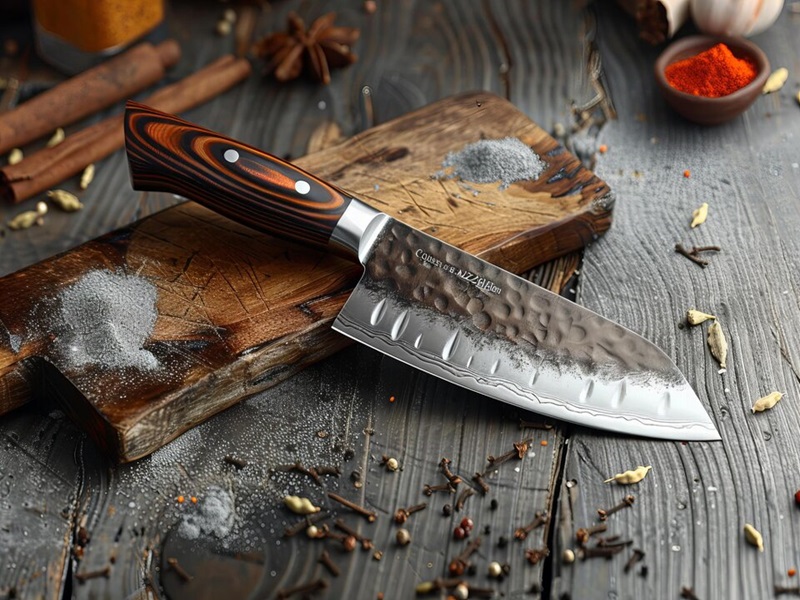Introduction
Bull cutter knives are essential tools in the butchery world, designed to handle the toughest cuts of meat. However, like any specialized tool, they come with their own set of challenges. Understanding these potential problems can help you make the most of your knife, ensuring it remains an effective and safe tool in your kitchen. In this article, we’ll explore 10 common problems you might face with bull cutter knives and how to address them.
Problem 1: Difficulty in Maintaining Sharpness
A sharp blade is crucial for the effectiveness of any knife, especially a bull cutter knife. However, maintaining that sharpness can be a challenge.
Causes of Blade Dullness
Frequent use, improper storage, and cutting through bones or hard materials can all contribute to the dulling of your bull cutter knife. Over time, even the highest quality blades will lose their edge if not properly maintained.
Solutions for Keeping the Blade Sharp
To keep your blade sharp, it’s essential to use a honing rod regularly and sharpen the knife with a whetstone or professional sharpening service as needed. Proper storage, such as using a knife block or magnetic strip, can also prevent unnecessary dulling.
Problem 2: Rust and Corrosion
Rust and corrosion are common issues with bull cutter knives, particularly if they’re made from high-carbon steel.
How to Prevent Rust on Bull Cutter Knives
Preventing rust requires diligent care. Always dry your knife thoroughly after washing, and avoid leaving it in damp environments. Applying a thin layer of food-safe oil to the blade can also help protect it from moisture.
Cleaning and Maintenance Tips
Hand washing with warm, soapy water is the best way to clean your bull cutter knife. Avoid using a dishwasher, as the harsh detergents and high heat can damage the blade and cause rust. Regularly inspect the knife for any signs of corrosion and address them promptly.
Problem 3: Handle Slippage
A secure grip is vital when using a bull cutter knife, but handle slippage can occur, especially when dealing with greasy or wet meat.
Common Causes of Handle Slippage
Handles made from smooth materials or those without ergonomic design can become slippery, posing a safety hazard. Over time, wear and tear can also make the handle less grippy.
How to Ensure a Secure Grip
Choose a knife with a handle made from textured or rubberized materials for better grip. Additionally, make sure the handle is ergonomically designed to fit comfortably in your hand. If slippage becomes an issue, consider using grip-enhancing gloves.
Problem 4: Weight and Balance Issues
The weight and balance of a bull cutter knife significantly impact its ease of use and effectiveness.
Impact of Poor Balance on Cutting Efficiency
A poorly balanced knife can lead to uneven cuts and increased fatigue during use. It may also cause the knife to feel unwieldy, making it harder to control.
Choosing a Well-Balanced Knife
When selecting a bull cutter knife, test its balance by holding it at the point where the blade meets the handle. The knife should feel stable and not tip forward or backward. A well-balanced knife will make your cutting tasks easier and safer.
Problem 5: Blade Chipping
Blade chipping can occur when the knife is used improperly or when it comes into contact with hard materials.
Reasons Why Blades Chip
Cutting through bones, using the knife on hard surfaces like glass or stone, or dropping the knife can all cause the blade to chip. Chipping is more common in harder steels, which, while sharper, are also more brittle.
Prevention and Repair Tips
To prevent chipping, avoid using the knife on hard surfaces and handle it with care. If chipping does occur, minor chips can be sharpened out, but more significant damage may require professional repair.
Problem 6: Difficulty in Sharpening
Sharpening a bull cutter knife can be tricky, particularly if you’re not familiar with the process.
Challenges in Sharpening Bull Cutter Knives
The large size and thick blade of a bull cutter knife can make sharpening more challenging compared to smaller knives. Improper sharpening techniques can also result in an uneven edge.
Tools and Techniques for Effective Sharpening
Using a whetstone is the preferred method for sharpening bull cutter knives. Take your time and ensure you maintain a consistent angle while sharpening. If you’re unsure, it might be worth investing in a sharpening guide or seeking professional sharpening services.
Problem 7: Blade Flexibility
While some flexibility in a knife blade can be beneficial, too much flexibility can be a problem, particularly with bull cutter knives.
When Flexibility Becomes a Problem
Excessive blade flexibility can make it difficult to cut through tough meat and bones, leading to imprecise cuts and increased effort. A blade that flexes too much can also be more prone to bending or breaking.
Selecting the Right Blade for Your Needs
When choosing a bull cutter knife, opt for one with a rigid blade that offers minimal flex. This will provide the necessary strength and control for cutting through dense materials.
Problem 8: Difficulty in Handling Large Cuts of Meat
Bull cutter knives are designed for large cuts, but their size and weight can make them difficult to handle, especially for beginners.
Issues with Control and Precision
The large blade can be challenging to control, leading to imprecise cuts and increased risk of injury. It can also be tiring to use for extended periods.
Tips for Improving Technique
To improve your technique, practice using the knife on smaller cuts of meat before tackling larger ones. Ensure you have a stable cutting surface and use your free hand to guide the knife for more precise cuts. Regular practice will help you build the strength and control needed to handle the knife effectively.
Problem 9: Short Lifespan
Despite their durability, bull cutter knives can have a shorter lifespan if not properly cared for.
Factors Contributing to a Knife’s Short Lifespan
Poor maintenance, improper use, and subpar materials can all shorten the lifespan of a bull cutter knife. Frequent exposure to moisture and improper storage can also cause the knife to degrade more quickly.
How to Extend the Life of Your Bull Cutter Knife
To extend the life of your knife, focus on proper care and maintenance. Regular sharpening, thorough cleaning, and appropriate storage will help keep your knife in top condition. Investing in a high-quality knife from a reputable brand can also ensure longevity.
Problem 10: Safety Concerns
Safety should always be a top priority when using a bull cutter knife. However, the size and sharpness of these knives can pose certain risks.




